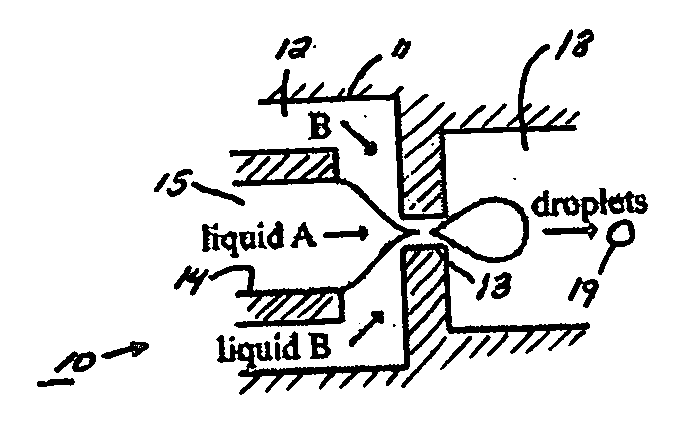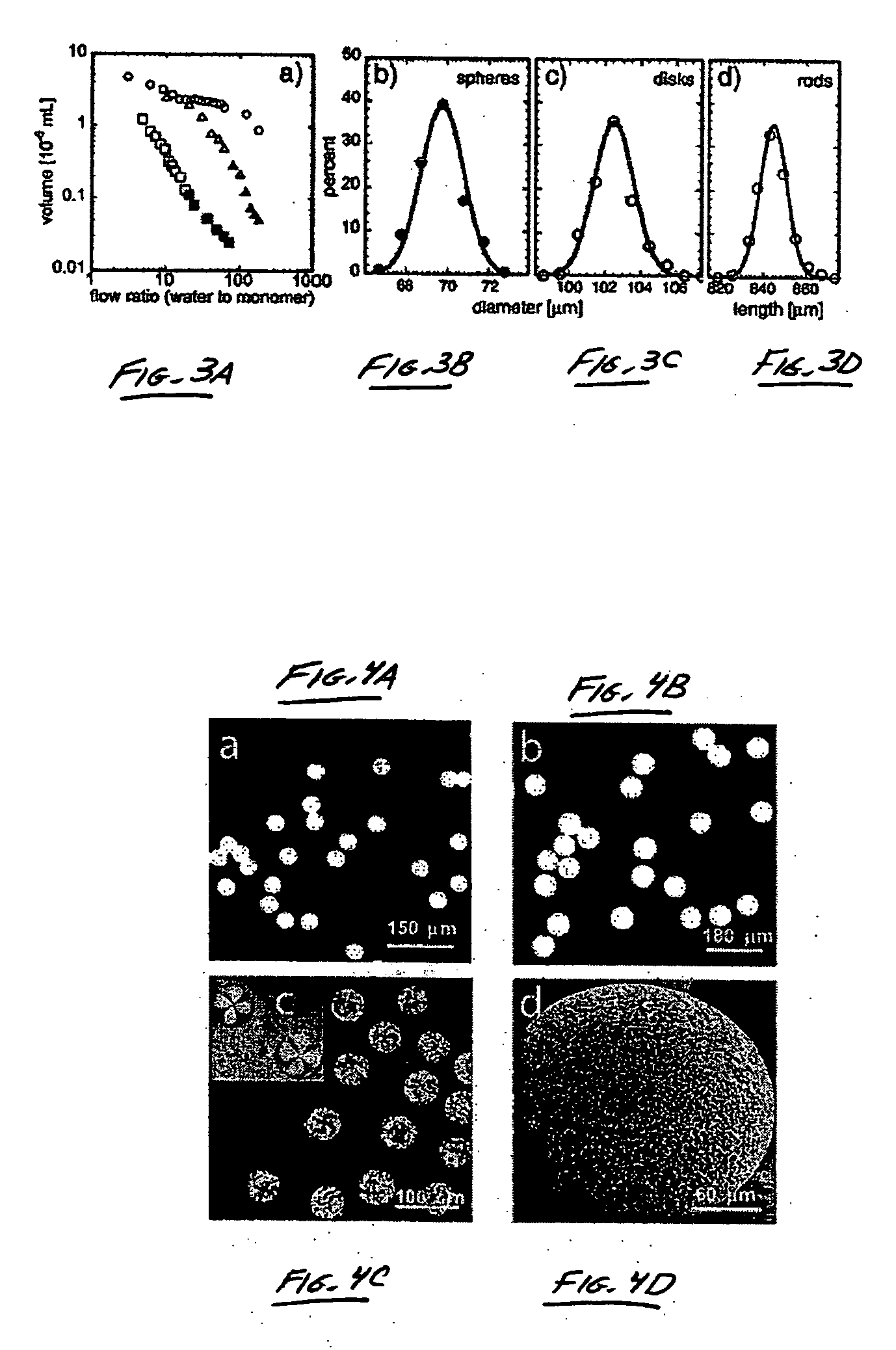Systems and methods of forming particles
a technology of system and particle, applied in the field of system and method of forming particles, can solve the problems of prone to failure, unsuitable for control of very small dispersed phase droplets, and traditional industrial processes typically involve manufacturing equipment built to operate on size scales generally unsuitable for precise control
- Summary
- Abstract
- Description
- Claims
- Application Information
AI Technical Summary
Benefits of technology
Problems solved by technology
Method used
Image
Examples
example 1
[0077] This example illustrates the formation of substantially monodisperse droplets using flow focusing techniques, where at least 90% of the droplets are within 5% of the median size. Dispersities were determined by curve fitting of the experimental histograms of the size of the particles with Gaussian distributions. The standard deviations were typically on the order of 1%-2% of the mean size.
[0078] Various microfluidic flow-focusing devices (“MFFD”) were used in this example to generate fluidic droplets, using techniques similar to those described in International Patent Application No. PCT / US03 / 20542, filed Jun. 30, 2003, entitled “Method and Apparatus for Fluid Dispersion,” by Stone, et al., published as WO 2004 / 002627 on Jan. 8, 2004; and International Patent Application No. PCT / US2004 / 027912, filed Aug. 27, 2004, entitled “Electronic Control of Fluidic Species,” by Link, et al., each incorporated herein by reference. A schematic diagram of a microfluidic flow-focusing devic...
example 2
[0081] The monodisperse droplets formed in the MFFD described in Example 1 were used to prepare particles in this example by solidifying these drops, either photochemically or thermally. FIG. 1B is a schematic diagram showing the polymerization of monomer droplets, and FIG. 1C is a schematic diagram showing the cooling of hydrogels or metals below their gelation or melting temperature, respectively. In these figures, the dashed rectangles 20 mark the position of the flow-focusing device shown in FIG. 1A. The channels used for photochemical cross-linking were also lengthened in this example to allow for generally longer durations of exposure of the droplets to UV light. This is shown in FIG. 1B as a “wavy” channel 5, eliminated by UV light source 27.
[0082] In various experiments, polymerization was used to produce monodisperse, solid, shaped particles from tripropyleneglycol diacrylate (“TPGDA”), dimethacrylate oxypropyldimethylsiloxane (“DMOS”), divinyl benzene (“DVB”), ethylenegly...
example 3
[0091] In this example, non-spherical particles were produced using the MFFD described in Example 1. In some experiments, agarose disks and bismuth alloy ellipsoids were produced using methods similar to those described in Example 2, for example, by introducing a fluidic droplet having a volume such that the fluidic droplet, within the outlet channel, was not able to form a spherical shape, and instead, formed a non-spherical shape. For example, a rod, a disk, an ellipsoid, etc. Other examples of non-spherical particles are described in this example, and are illustrated in FIG. 2.
[0092]FIGS. 2A-2G are a series of optical microscopy images of polyTPGDA particles, some of which are non-spherical: microspheres (FIG. 2A), crystal of microspheres (FIG. 2B), rods (FIG. 2C), disks (FIG. 2D), and ellipsoids (FIG. 2E). Rods were prepared having aspect ratios as large as 1:12 FIG. 1C). The ellipsoid particles were formed at relatively high flow rates of the continuous phase in the wavy chann...
PUM
| Property | Measurement | Unit |
|---|---|---|
| Length | aaaaa | aaaaa |
| Length | aaaaa | aaaaa |
| Length | aaaaa | aaaaa |
Abstract
Description
Claims
Application Information
 Login to View More
Login to View More - R&D
- Intellectual Property
- Life Sciences
- Materials
- Tech Scout
- Unparalleled Data Quality
- Higher Quality Content
- 60% Fewer Hallucinations
Browse by: Latest US Patents, China's latest patents, Technical Efficacy Thesaurus, Application Domain, Technology Topic, Popular Technical Reports.
© 2025 PatSnap. All rights reserved.Legal|Privacy policy|Modern Slavery Act Transparency Statement|Sitemap|About US| Contact US: help@patsnap.com



